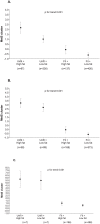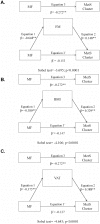Fatness mediates the influence of muscular fitness on metabolic syndrome in Colombian collegiate students
- PMID: 28296952
- PMCID: PMC5352003
- DOI: 10.1371/journal.pone.0173932
Fatness mediates the influence of muscular fitness on metabolic syndrome in Colombian collegiate students
Abstract
The purpose of this study was two-fold: to analyze the association between muscular fitness (MF) and clustering of metabolic syndrome (MetS) components, and to determine if fatness parameters mediate the association between MF and MetS clustering in Colombian collegiate students. This cross-sectional study included a total of 886 (51.9% women) healthy collegiate students (21.4 ± 3.3 years old). Standing broad jump and isometric handgrip dynamometry were used as indicators of lower and upper body MF, respectively. Also, a MF score was computed by summing the standardized values of both tests, and used to classify adults as fit or unfit. We also assessed fat mass, body mass index, waist-to-height ratio, and abdominal visceral fat, and categorized individuals as low and high fat using international cut-offs. A MetS cluster score was derived by calculating the sum of the sample-specific z-scores from the triglycerides, HDL cholesterol, fasting glucose, waist circumference, and arterial blood pressure. Linear regression models were used to examine whether the association between MF and MetS cluster was mediated by the fatness parameters. Data were collected from 2013 to 2016 and the analysis was done in 2016. Findings revealed that the best profiles (fit + low fat) were associated with lower levels of the MetS clustering (p <0.001 in the four fatness parameters), compared with unfit and fat (unfit + high fat) counterparts. Linear regression models indicated a partial mediating effect for fatness parameters in the association of MF with MetS clustering. Our findings indicate that efforts to improve MF in young adults may decrease MetS risk partially through an indirect effect on improvements to adiposity levels. Thus, weight reduction should be taken into account as a complementary goal to improvements in MF within exercise programs.
Conflict of interest statement
Figures


Similar articles
-
Association of Muscular Fitness and Body Fatness with Cardiometabolic Risk Factors: The FUPRECOL Study.Nutrients. 2018 Nov 12;10(11):1742. doi: 10.3390/nu10111742. Nutrients. 2018. PMID: 30424569 Free PMC article.
-
Optimal Adherence to a Mediterranean Diet and High Muscular Fitness Are Associated with a Healthier Cardiometabolic Profile in Collegiate Students.Nutrients. 2018 Apr 20;10(4):511. doi: 10.3390/nu10040511. Nutrients. 2018. PMID: 29677099 Free PMC article.
-
Comparison of Three Adiposity Indexes and Cutoff Values to Predict Metabolic Syndrome Among University Students.Metab Syndr Relat Disord. 2017 Sep;15(7):363-370. doi: 10.1089/met.2017.0016. Epub 2017 Jun 1. Metab Syndr Relat Disord. 2017. PMID: 28570830
-
Muscular Fitness and Cardiovascular Risk Factors in Children and Adolescents: A Systematic Review.J Strength Cond Res. 2020 Aug;34(8):2394-2406. doi: 10.1519/JSC.0000000000002840. J Strength Cond Res. 2020. PMID: 30273286
-
Effects of total fat intake on body fatness in adults.Cochrane Database Syst Rev. 2020 Jun 1;6(6):CD013636. doi: 10.1002/14651858.CD013636. Cochrane Database Syst Rev. 2020. PMID: 32476140 Free PMC article.
Cited by
-
Muscle strength cut-offs for the detection of metabolic syndrome in a nonrepresentative sample of collegiate students from Colombia.J Sport Health Sci. 2020 May;9(3):283-290. doi: 10.1016/j.jshs.2018.09.004. Epub 2018 Sep 11. J Sport Health Sci. 2020. PMID: 32444153 Free PMC article.
-
Changes in muscular fitness and its association with blood pressure in adolescents.Eur J Pediatr. 2018 Jul;177(7):1101-1109. doi: 10.1007/s00431-018-3164-4. Epub 2018 May 8. Eur J Pediatr. 2018. PMID: 29740692
-
Glucose Levels as a Mediator of the Detrimental Effect of Abdominal Obesity on Relative Handgrip Strength in Older Adults.J Clin Med. 2020 Jul 22;9(8):2323. doi: 10.3390/jcm9082323. J Clin Med. 2020. PMID: 32707776 Free PMC article.
-
Optimal Adherence to a Mediterranean Diet May Not Overcome the Deleterious Effects of Low Physical Fitness on Cardiovascular Disease Risk in Adolescents: A Cross-Sectional Pooled Analysis.Nutrients. 2018 Jun 25;10(7):815. doi: 10.3390/nu10070815. Nutrients. 2018. PMID: 29941782 Free PMC article.
-
Association of Muscular Fitness and Body Fatness with Cardiometabolic Risk Factors: The FUPRECOL Study.Nutrients. 2018 Nov 12;10(11):1742. doi: 10.3390/nu10111742. Nutrients. 2018. PMID: 30424569 Free PMC article.
References
-
- Williams MA, Haskell WL, Ades PA, Amsterdam EA, Bittner V, Franklin BA, et al. Resistance exercise in individuals with and without cardiovascular disease: 2007 update a scientific statement from the american heart association council on clinical cardiology and council on nutrition, physical activity, and metabolism. Circulation. 2007;116(5):572–584. 10.1161/CIRCULATIONAHA.107.185214 - DOI - PubMed
MeSH terms
LinkOut - more resources
Full Text Sources
Other Literature Sources
Medical

